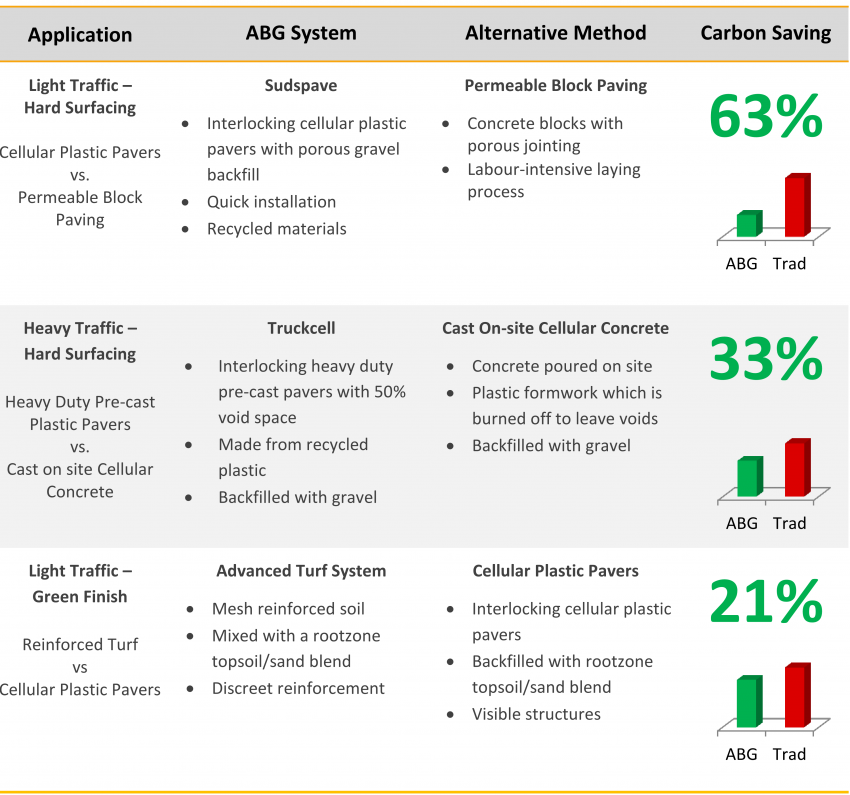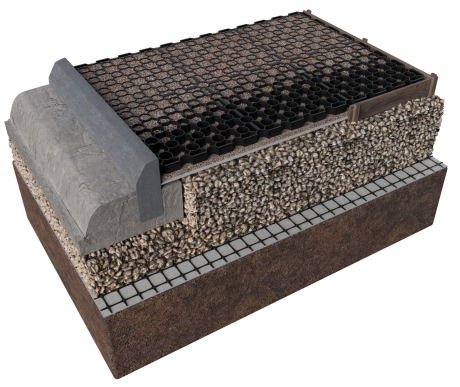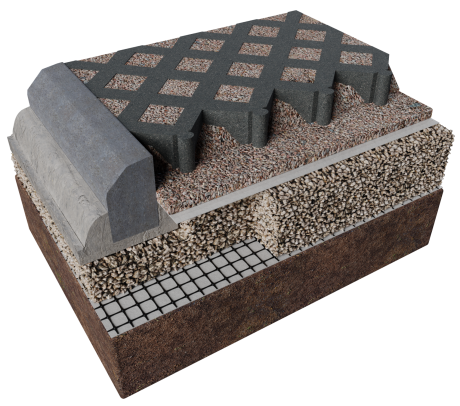The table below shows examples of the percentage carbon saving potential by using ABG Porous Paving solutions.
Carbon Footprint Reduction: ABG Porous Paving systems




Truckcell with Gravel Backfill
General Assumptions
The analysis method follows that described in the WRAP report (Corney, 2010). The carbon associated with four key stages is assessed a) the carbon associated with waste soil, b) the embodied carbon of imported materials, c) the transportation of imported materials to site, and d) the carbon associated with construction on site. For simplicity, the carbon footprint associated with excavation and road foundation construction (including the carbon associated with waste soil) has not been included in these assessments – just the surfacing is compared. The carbon footprint associated with construction is also discounted due to the difficulty of comparison, although it is expected that the installation of the ABG solutions will have a lower carbon footprint.
The fuel efficiency of the vehicles used is assumed to be 4.4 miles/L (the measured fuel efficiency of ABG lorries). The carbon footprint of burning diesel is assessed as 2.67 kgCO2e/L based on the value given for ‘Diesel (average biofuel blend)’ in the DEFRA report (Department for Environment Food & Rural Affairs, 2018).
The embodied carbon of the various imported gravels used in these assessments is assumed to be quarried limestone or similar, with an embodied carbon footprint of 0.0052 kgECO2e/kg (kilograms of embodied carbon dioxide equivalent per kilogram of product) as per the ICE report (Hammond and Jones, 2011) for ‘Aggregate – General (Gravel of Crushed Rock)’. The embodied carbon of all ABG’s geosynthetics products is based on ABG internal assessments (Heritage, 2018) and ‘Obtaining reliable embodied carbon values for geosynthetics’ (Raja, 2015).
The transportation of imported materials is based on the installation site being 100 miles from ABG and 5 miles from the nearest quarry. Fuel economy is estimated as 4.4 miles/L. The weight of material transported varies for each item. The carbon footprint associated with construction is based on estimates where possible and ignored in more complicated situations for simplicity of calculations.
Light Traffic – Hard Surfacing
This assessment was based on a permeable block paving surfacing compared with ABG Sudspave – a porous paving surface comprising interlocking plastic pavers backfilled with gravel. The permeable block paving is based on a 60mm paver on a 50mm bedding layer. The embodied carbon of the block paving is assessed as 36 kgCO2e/kg (Marshalls.co.uk, 2018) which includes transportation. Added to this is the embodied carbon in the bedding layer and fine gravel in the joints between the pavers. The Sudspave design is a 40mm plastic paver on a 20mm bedding layer (a design which is, generally, structurally and hydraulically equivalent or better). The carbon footprint of the Sudspave solution is based on 1) the embodied carbon of Sudspave pavers, the gravel infill and bedding materials and a layer of separation geotextile; and 2) the transportation of these materials to site. The embodied carbon of the Sudspave pavers is based on the value used by ABG when assessing the carbon footprint of 100% recycled HDPE.
Heavy Traffic – Hard Surfacing
This assessment was based on cast on-site porous cellular blocks compared with Truckcell. Cast on-site porous cellular concrete blocks are a system which consists of an egg-carton shaped plastic mould being laid on a prepared sub-base/bedding layer. Steel reinforcing bar is then placed in the mould and concrete poured to form a honeycomb shape (visually similar to Truckcell). The exposed plastic mould is then burnt off and the exposed voids are backfilled with (in the case of hard surfacing) porous gravel. So the carbon footprint of the cast on-site porous cellular blocks is based on 1) the embodied carbon of the plastic formwork, concrete, reinforcing steel and gravel backfill and bedding; 2) the carbon released when burning off the exposed plastic former, 3) the transport of all elements to site. The plastic former is assumed to come from a specialist supplier 100 miles from site (as per ABG materials) whereas the concrete and steel from 5 miles from site.
Truckcell is an 80mm heavy duty porous plastic paver made from 100% recycled plastic which is backfilled with, and has a 20mm thick bedding layer of, porous gravel. So the carbon footprint of the Truckcell option is based on 1) the embodied carbon of the Truckcell and gravel backfill and bedding; 2) the transport of all elements to site. The embodied carbon of the Truckcell is based on the declared value of 0.538 kg ECO2e/kg from the Environmental Product Declaration.
Light Traffic – Green Finish
This assessment was based on cellular plastic pavers compared with ABG Advanced Turf System (ATS) – a porous turf reinforcing system comprising mesh elements blended with sandy rootzone growing media. It is assumed that the rootzone/topsoil is carbon neutral due to the carbon absorbed during the life of the vegetation (typically grass) planted. The carbon footprint of the ATS is based on the embodied carbon of a typical 200mm thick surfacing with 5.4kg of mesh elements per m3, a separation geotextile at the base and transportation of materials to site. The embodied carbon of the mesh elements is based on the recommended value for PP geogrid (Raja, 2015). As ATS requires a specialist to mix the mesh and rootzone, the transportation to site is based on a 100 mile journey as with other ABG products. The carbon footprint of the cellular plastic pavers is based on the assessment for Sudspave (see ‘Light Traffic – Hard Surfacing’) but with the gravel backfill and bedding being replaced with sandy rootzone backfill (40mm) and bedding layer (50mm). As with ATS, the rootzone is assumed to be carbon neutral, but transported from 5 miles away rather than 100 miles.
References
Corney, N. et. al. (2010) Sustainable Geosystems in civil engineering applications, WRAP Geosystems Report MRF116-001
Department for Environment Food & Rural Affairs (2018). UK Government GHG Conversion Factors for Company Reporting.
Hammond, G. & Jones, C. (2011) Inventory of Carbon & Energy (ICE) Version 2.0, Sustainable Energy Research Team (SERT) Department of Mechanical Engineering, University of Bath, UK
Heritage, R. (2018) Embedded Carbon of ABG Geosynthetics, ABG Technical Note [Not yet published]
Marshalls.co.uk (2018) Carbon Footprint Calculator for Hard Landscaping. [online] Available at: https://www.marshalls.co.uk/homeowners/hard-landscaping-carbon-footprint-calculator [Accessed 18 Sep. 2018].
Raja, J., Dixon, N., Fowmes, G., Frost, M. and Assinder, P. (2015). Obtaining reliable embodied carbon values for geosynthetics. Geosynthetics International. [http://dx.doi.org/10.1680/gein.15.00020]
Wilson, S. (2018) A14 Deckdrain Back of Wall Drainage, Costain Case Study [Not yet published]